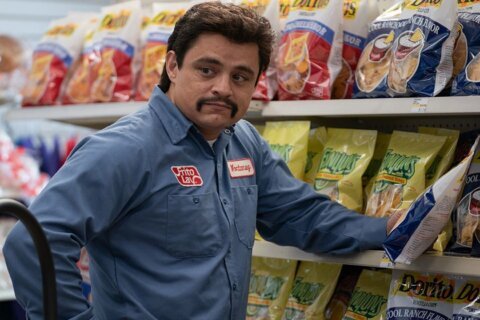MIDDLEBURG, Va. – Of all the events at this past weekend’s inaugural Middleburg Film Festival, Sunday had to be the most personal for festival founder Sheila Johnson. That’s because a movie she executive produced, “The Butler” (2013), screened at the Sheila C. Johnson Performing Arts Center at The Hill School in Middleburg.
Guests both watched the movie and engaged in a lively Q&A with the film’s director Lee Daniels and Washington Post writer Wil Haygood, who wrote the article that inspired the movie. His article followed real-life White House butler Eugene Allen, who served every president from Harry Truman to Ronald Reagan, and inspired the film’s fictional character Cecil Gaines.
Daniels said Hollywood was hesitant to make “The Butler,” due to its place as a historical drama with a largely black cast, but its $115 million domestic gross is proof that studios continue to underestimate American audiences. When asked what attracted him to the story, he said it was the father-son conflict, as he was at odds with his own teenage son at the time. “I’d say day, he’d say night. I’d say black, he’d say white.” Speaking of black and white, Daniels said the film is a reminder that the Civil Rights Movement was fueled by black kids and white kids fighting together for the soul of America.
As for Haygood, he nearly stole the show when asked how his life has changed since the success of the movie. In pure deadpan, he said he’s heard from the two girls who turned him down for senior prom, putting the audience in stitches. He also explained how much of the movie was true and how much was fictional (more on this below), including a story about Allen’s real-life son, who cried at how much Forest Whitaker and Oprah Winfrey captured the essence of his parents’ relationship.
The most fascinating part of the discussion came as Haygood described his 2008 meeting with then 89-year-old Allen and his wife at their home. He described how the couple unlocked the basement door and took him downstairs to a secret room filled with photos of Allen and numerous presidents. At one point, Allen’s wife yelled down the stairs, “Show him the one of me and Ella Fitzgerald!” Haygood said he got goosebumps upon realizing he was the first to be able to share this incredible life story.
Before seeing the secret room, Haygood had to watch “The Price is Right” with the Allens as part of their daily routine. He then had to watch it again, as they enjoyed watching the reruns. After a while, he caught himself yelling at the television, “No, don’t bid that much for the refrigerator!”
And just like watching game show reruns, I found “The Butler” to be even better the second time. Not only did it carry the same power to make audiences laugh and cry, it revealed a slew of clever directing techniques you may have missed the first time around:
- The high angle as Cecil serves his first day as butler, making him appear physically the way he feels emotionally: small. If you look closely, the camera cranes slowly down to put him on equal footing: a sign of things to come.
- The butlers covering black hands with white gloves, echoing a lesson taught by Cecil’s childhood guardian: you need to have two faces, one to wear in public, one in private.
- The blocking during the first get together at the Gaines house, as the disaffected son sits by himself at the dinner table while the family laughs in the living room. Note that Whitaker comes downstairs to join his son in this scene, but by the movie’s end, it’s the son who comes downstairs to join his father to watch an historic election.
- The symbolism of his son looking out of the rear of a bus window as he rides off to college. Compare this to his riding with the Freedom Riders, where blacks and whites sit integrated on a bus in a new Rosa Parks equality.
- The juxtaposition of Cecil serving white dignitaries at a White House state dinner, while white diner workers refuse to serve black students at lunch counter sit-ins.
- The decision to show John F. Kennedy wearing a white bow tie early in his presidency, but after the Freedom Riders bus bombing, when he admits his heart is changed, he wears a black tie that Cecil keeps as a souvenir.
- The high angle above JFK as he lays on the Oval Office floor, eerily foreshadowing his death.
- The wideshot of a “colored” water fountain, as Cecil stands with his son on the “black” side.
- The dissolve from Cecil’s outstretched arms opening a White House door, to Dr. Martin Luther King Jr. standing in the exact same position on a Memphis motel balcony, his body like a crucifix, moments before his assassination.
- The familiar image of a neon crucifix, first in a hateful KKK cross burning, then next to a church sign that reads, “God is love,” reclaiming the cross for its true purpose.
- The Rubik’s cube on the desk with all colors aligned as he finally gets his equal pay justice.
The second viewing also diffused several criticisms that popped up after the film’s initial release:
1) Presidential Casting. The first time you see “The Butler,” the casting of A-listers in the presidential roles is jarring compared to the archival appearances of the actual presidents in “Forrest Gump.” Let’s face it, it takes some getting used to seeing Robin Williams as Dwight Eisenhower, John Cusack as Richard Nixon, James Marsden as John F. Kennedy or Alan Rickman as Ronald Reagan. Thankfully, this jolt fades on second viewing, allowing viewers to appreciate the acting choices employed by each actor. The presidential cast feels less like a group of imposters, and more like a collection of commendable talents giving valiant efforts in an impossible task.
2) Historical Accuracy. Many critics have sniped at the film’s factual embellishments, noting that Allen’s parents weren’t really Georgia sharecroppers who were raped and murdered — they in fact lived in Virginia — and that Allen’s real son was a Vietnam veteran, not a Black Panther. While the sharecropper bit is more egregious, there is a distinct dramatic benefit of dividing Allen’s single son into two different sons on screen: one who served in the war, and one who protested it. In the end, I’d much rather a film take artistic license with Allen’s personal life than with the historic fact of White House record. Which brings us to…
3) Political Fairness. In my original review, I spoke in depth about the filmmakers’ painstaking attempt at fairness in their political presentations, painting both Republican and Democratic presidents in a mix of positive and negative light. For instance, Reagan is the first president to give Cecil a raise (positive), but also opposes sanctions against South Africa’s Apartheid regime (negative). LBJ is shown passing the Civil Rights Act of 1964 and Voting Rights Act of 1965 (positive), but is shown as a buffoon on the toilet with his dogs, while launching a bloody Vietnam War (negative).
I did, however, worry that the movie might alienate present-day conservatives with its closing audio montage of three Democrats. Watching it again, I still think the audio montage is unnecessary, and after five years of partisan gridlock, those “Yes We Can” signs seem like a political eternity ago. And yet, whatever your thoughts on President Barack Obama, I’m convinced it would be impossible for the movie to come full circle without showing his historic election — the very election that inspired Haygood to publish the article. Just as the film opens with a black man waiting to apply for a butler job at the White House, it ends with him waiting as an invited guest by the nation’s first black president.
4) Sentimentality. The final complaint from some critics was the film’s sentimentality. I suppose this is a matter of taste, and those who found “The Butler” too sappy probably said the same thing about “The Color Purple.” Fair enough. I didn’t feel this way the first time, and I certainly didn’t feel it this time. But for those who did, I ask you to reconsider the film through the Memphis motel room scene, where Dr. King says the hardworking butler may appear subservient, but is actually quite subversive. Likewise, the movie “The Butler” may appear subservient to mainstream audiences, but it’s actually quite subversive — and could have a greater impact because more people will see it.
The film will most certainly contend for Best Picture with the Academy’s expansion to nine or 10 nominees. But even if it doesn’t win, it could have longer legs than its rivals once it hits cable and home video, just like “Shawshank,” where Morgan Freeman pleaded his case for rehabilitation just like Whitaker pleads for equal pay. “Gravity” was the multiplex experience of the year, but it won’t translate as well at home as it did in 3D/IMAX. “Before Midnight” will compete with its own trilogy installments for the attention of its niche audience. And “12 Years a Slave” and “Fruitvale Station” are the types of masterful works that are so emotionally intense that many folks won’t be watching them on a loop.
As such, expect “The Butler” to rise over time, at which point the 26 percent of critics who gave it a negative rating on Rotten Tomatoes may undergo a Kennedy- esque “change of heart.” I wish these folks could have sat there during Sunday’s “Butler” screening and Q&A at the Middleburg Film Festival. There’s no way to have sat in that room — mixed with young and old, black and white, casual moviegoers and serious film buffs — and not have walked out feeling cleansed.
Ages, colors and creeds were all rendered equal as late arrivals stumbled to find open seats in the darkness of the theater. Mid-way through the film, a group of African American festival staffers rushed to help an elderly white woman climb to her seat with the aid of flashlights. Seeing their random act of kindness, I told myself I would use the glow of my own cellphone to help the next person who entered.
A few minutes later, the door opened, and a large black man entered. He seemed dazed by the dark, so I lit his path to the empty seat next to me. I kept watching him as the film progressed, and the man never once watched the screen. He kept his head turned, gauging the audience’s reaction. When the credits rolled and the lights came up, the man had tears of joy streaming down his face.
It was Lee Daniels.
![]()
Follow WTOP Film Critic Jason Fraley on Twitter @JFrayWTOP, read his blog The Film Spectrum or listen Friday mornings on 103.5 FM.








